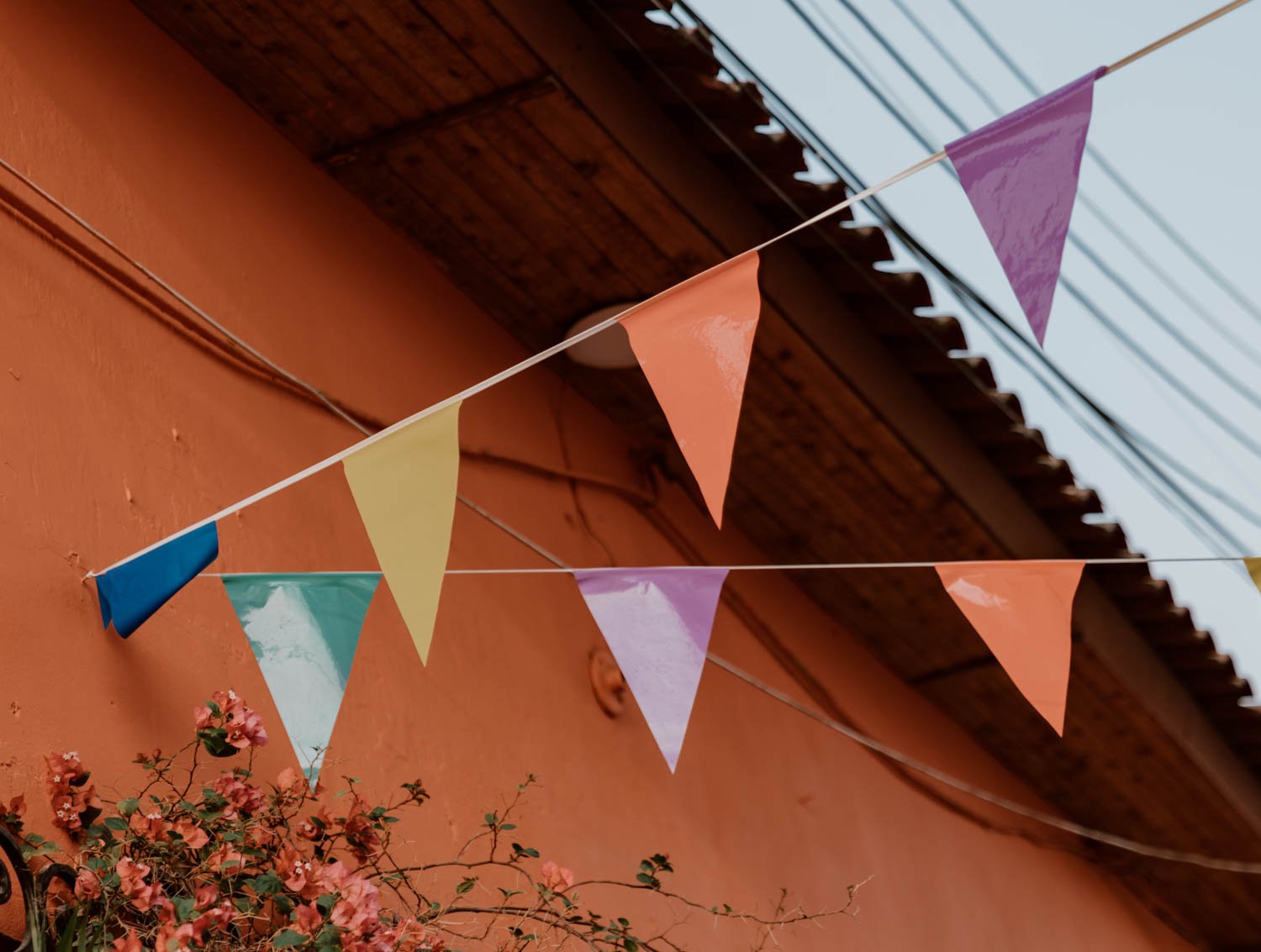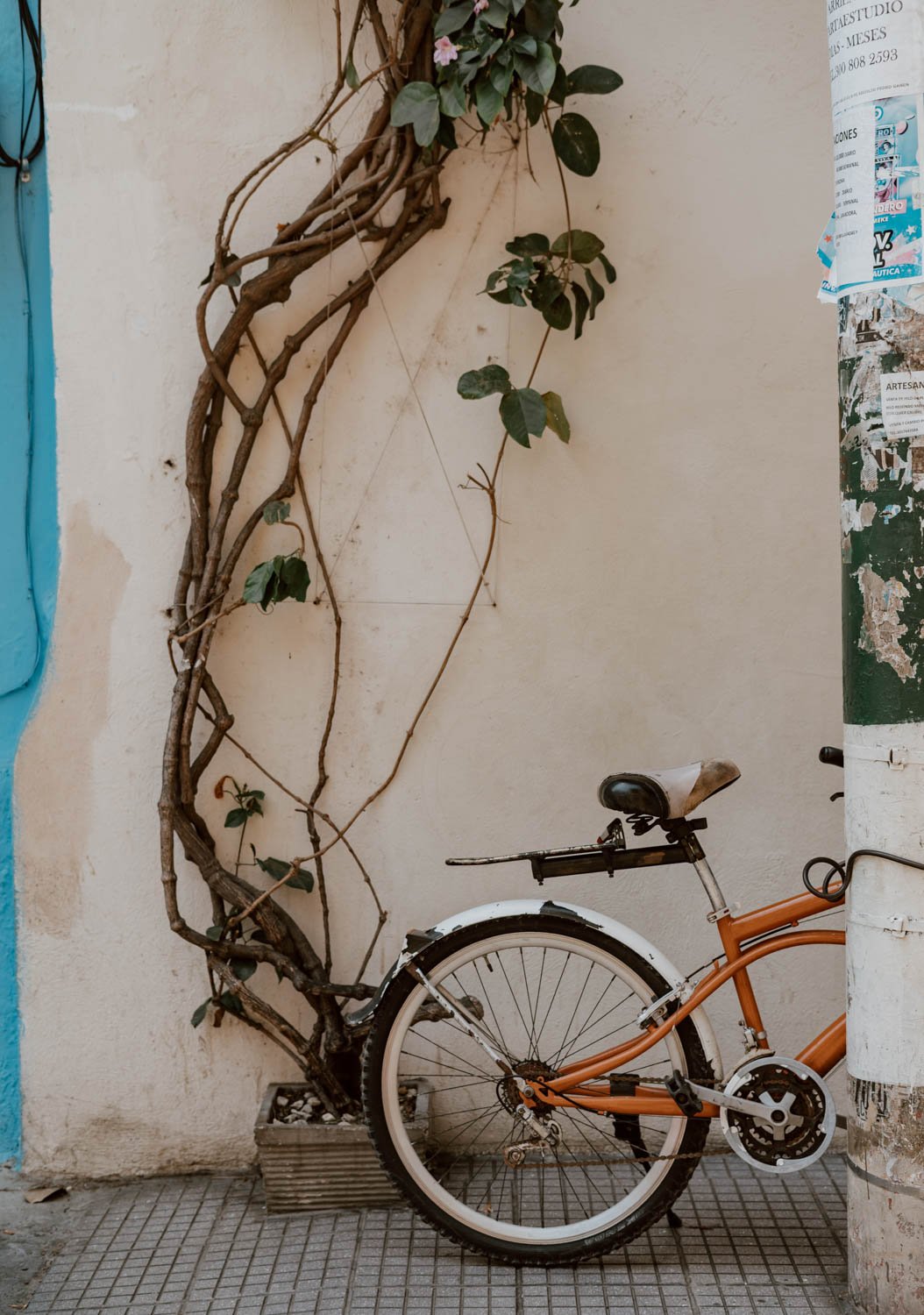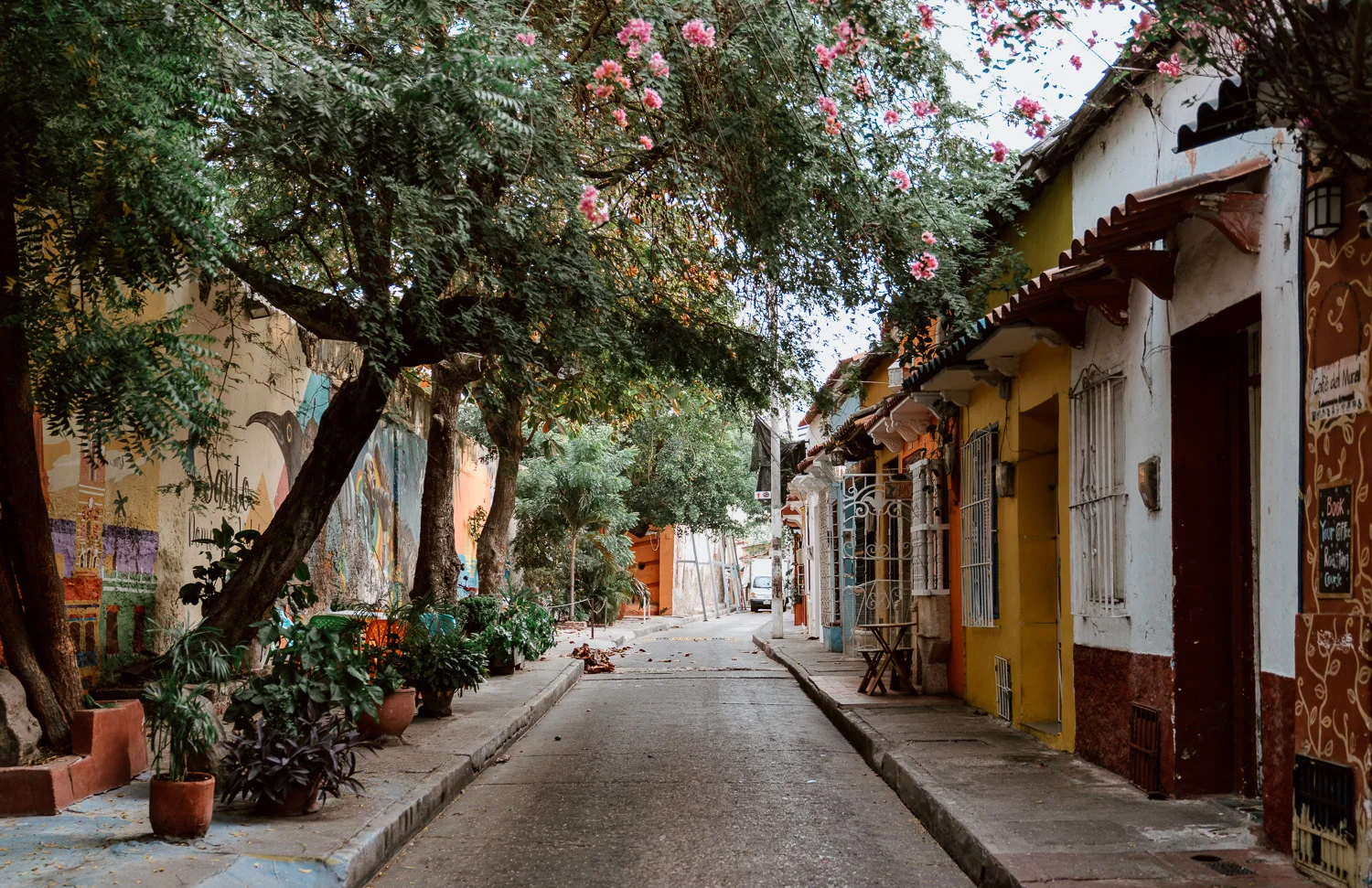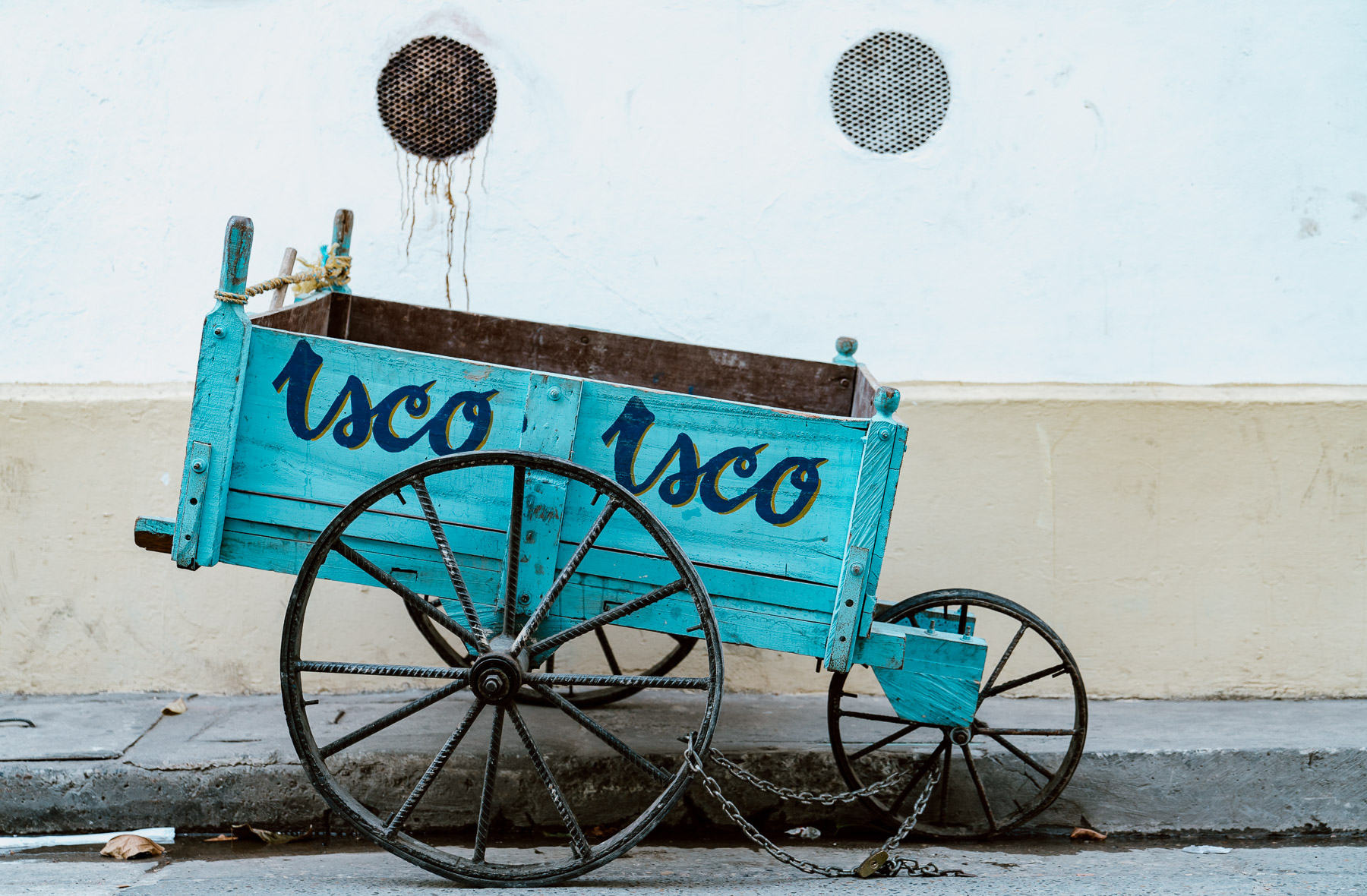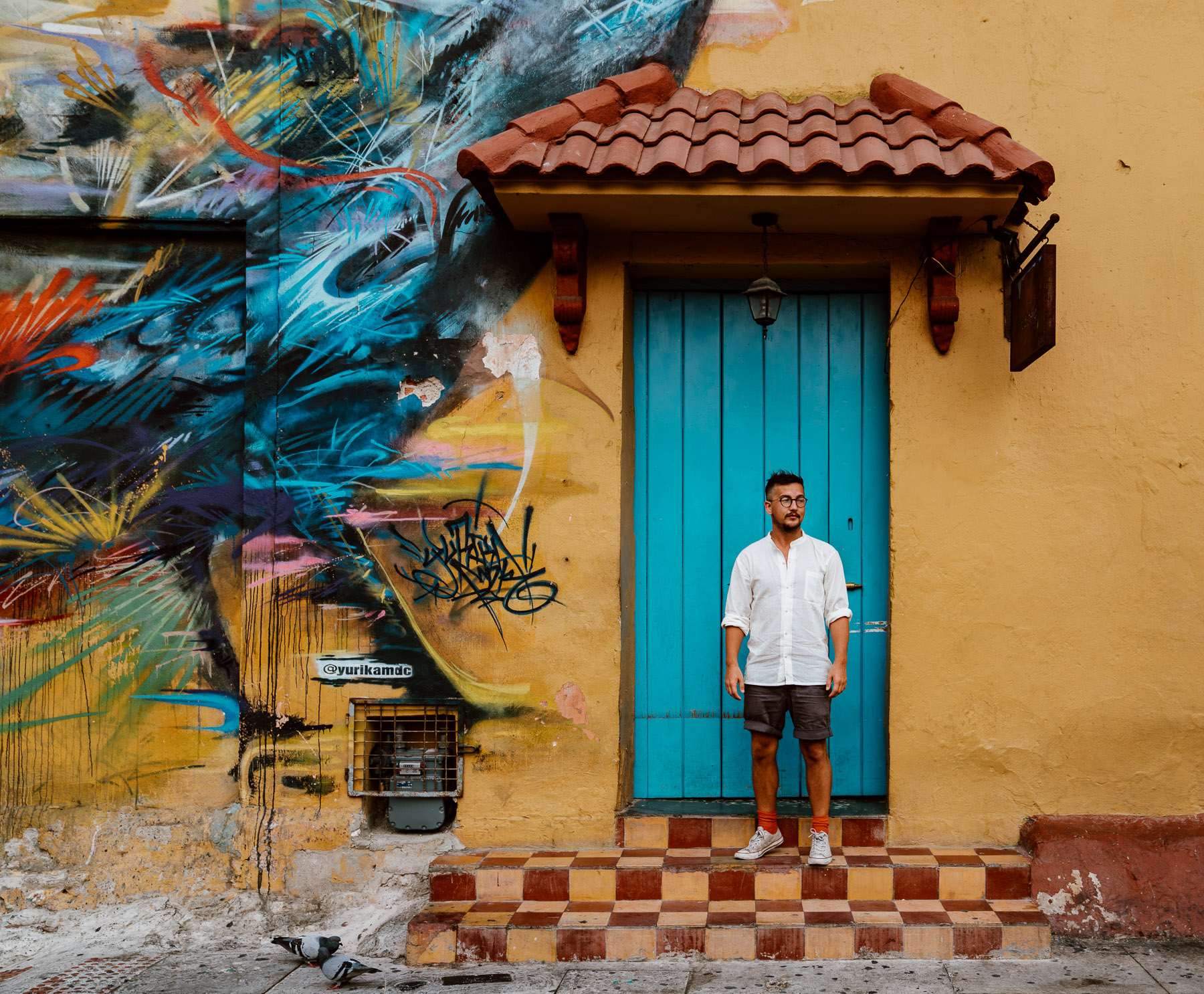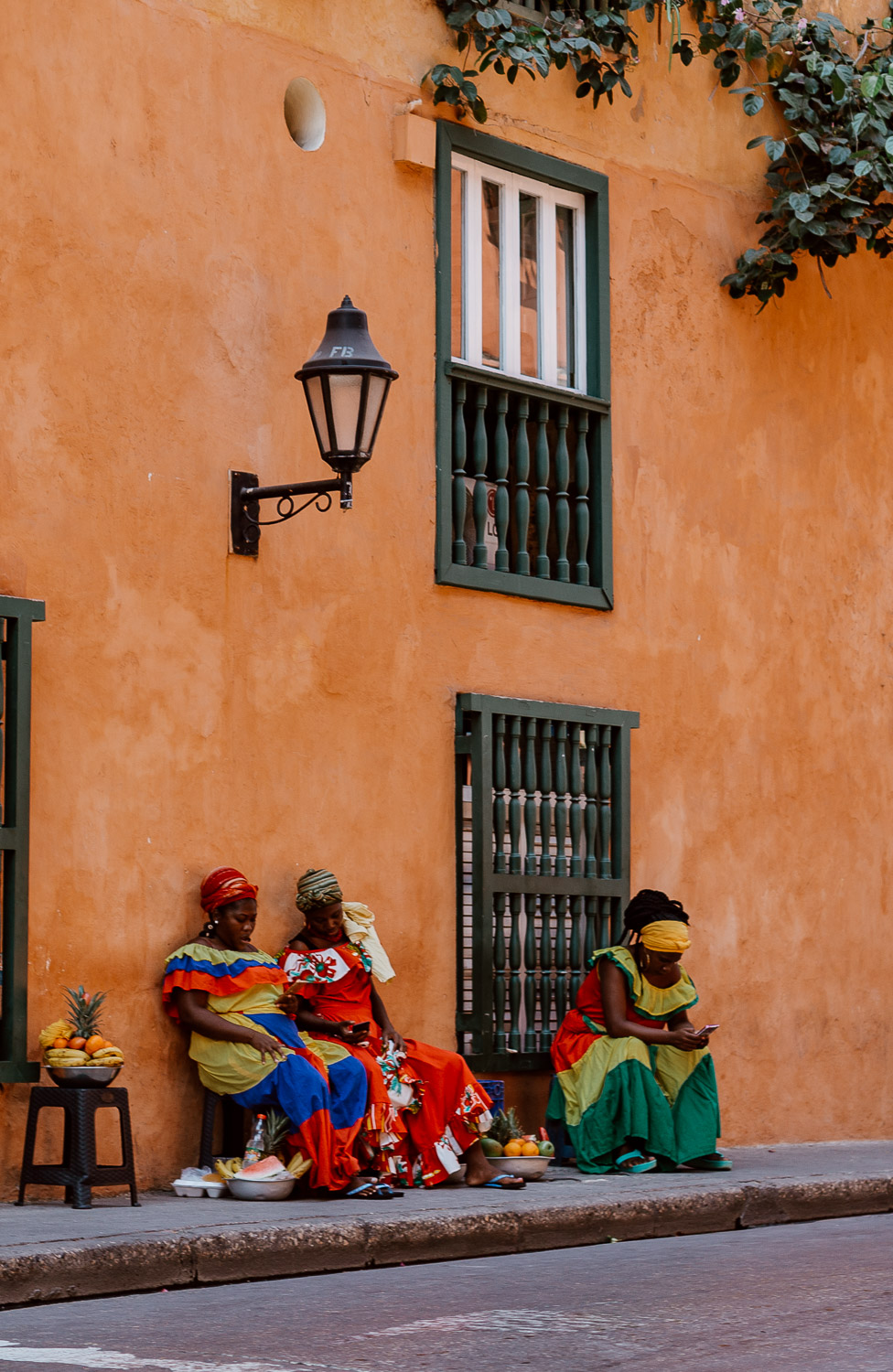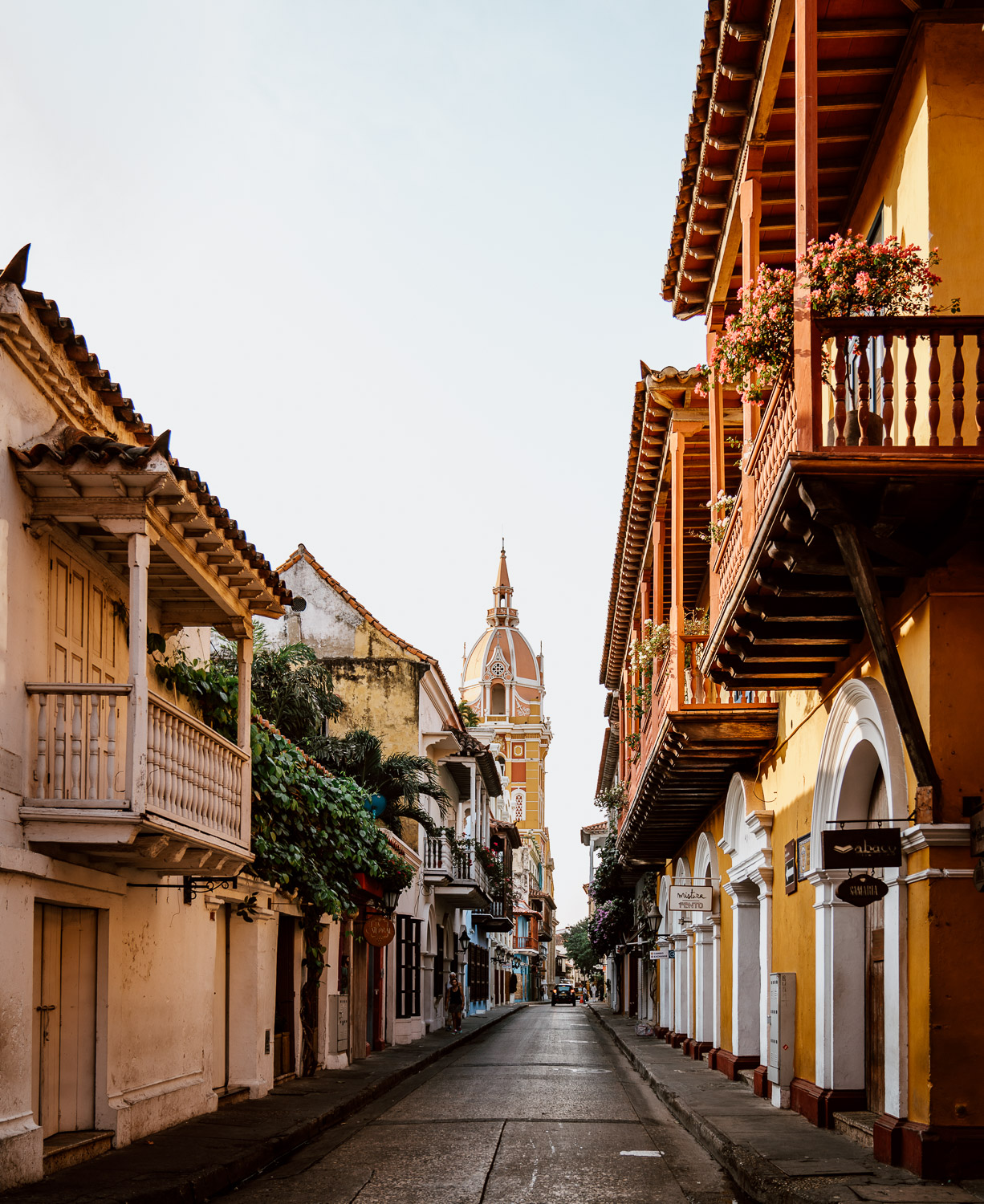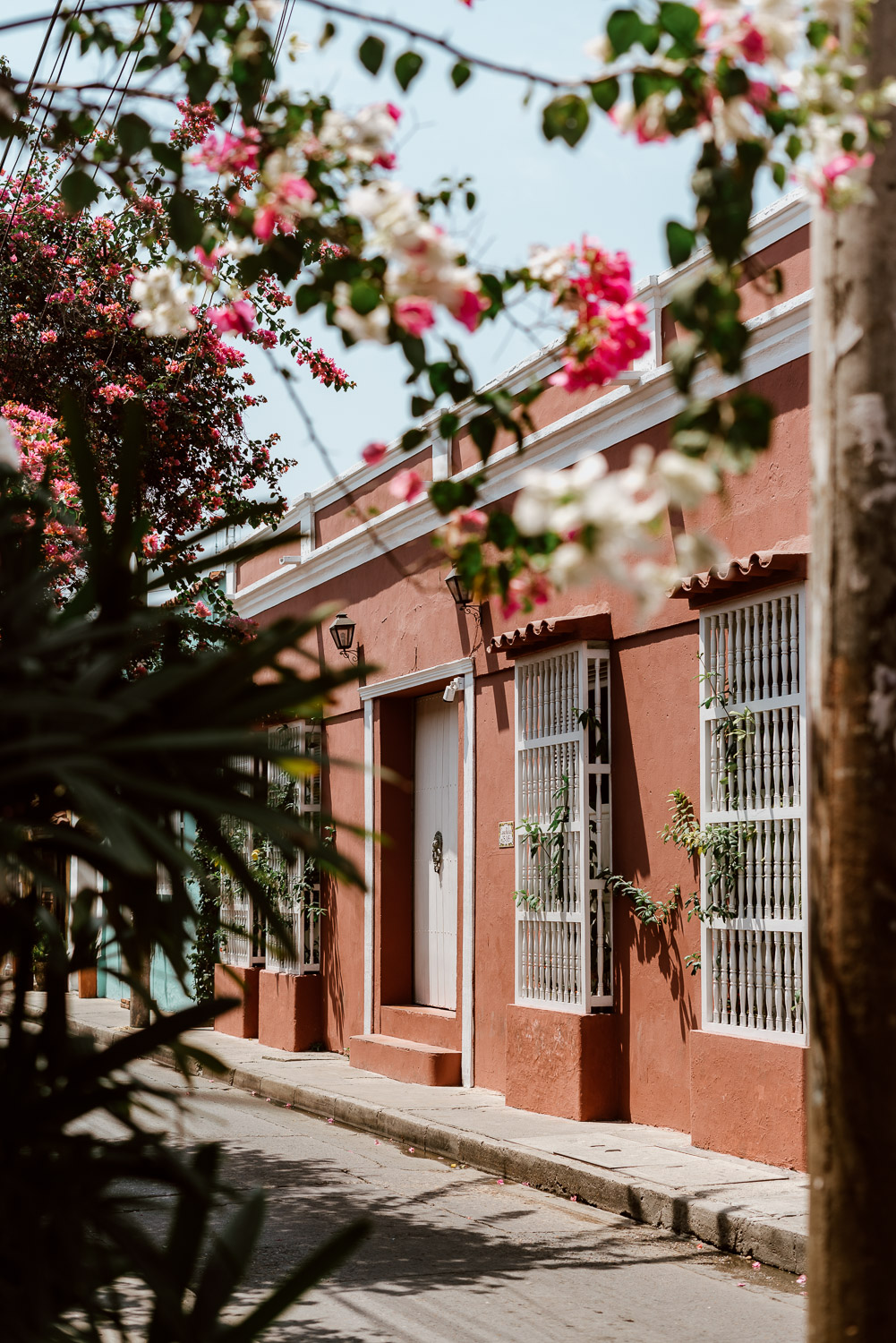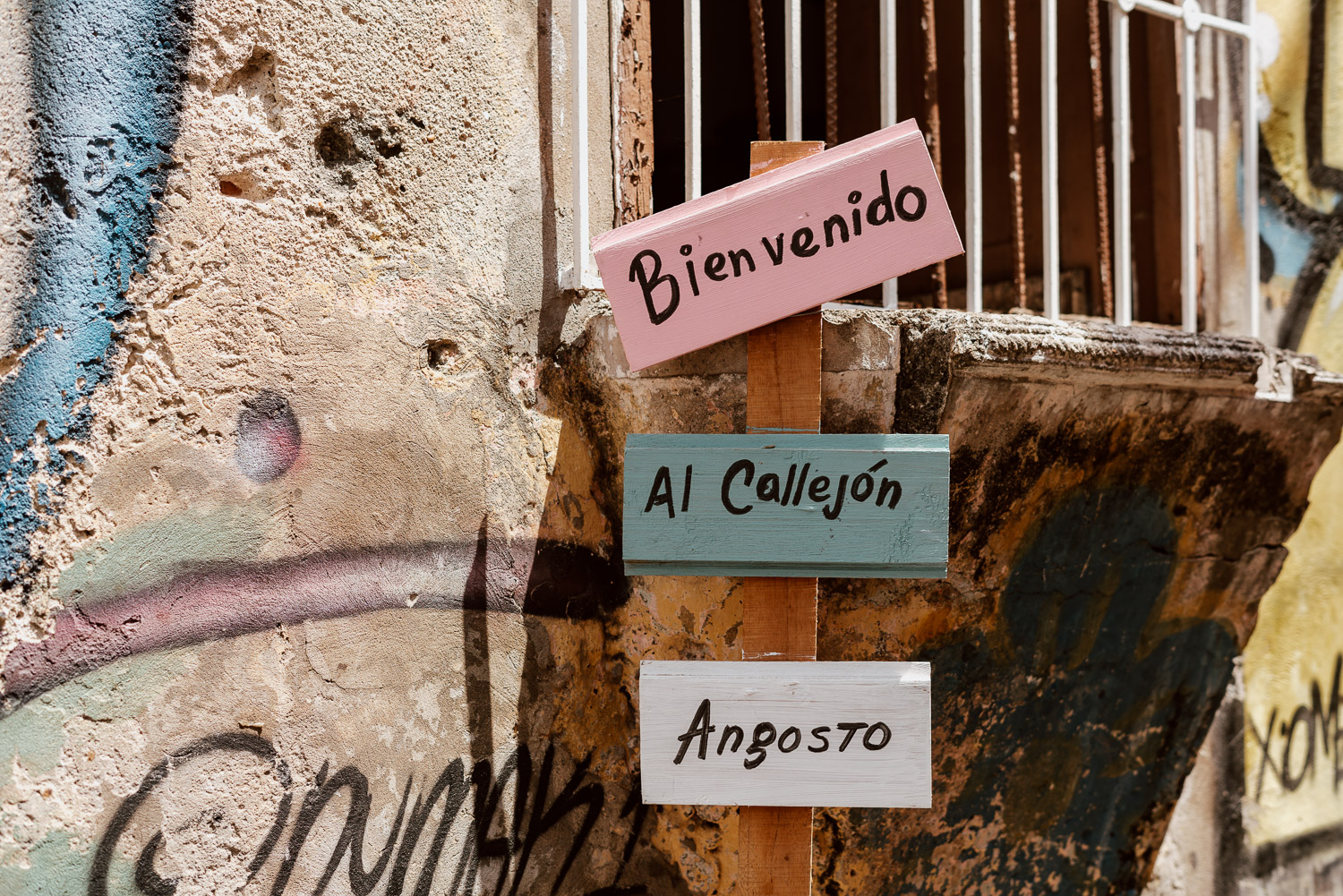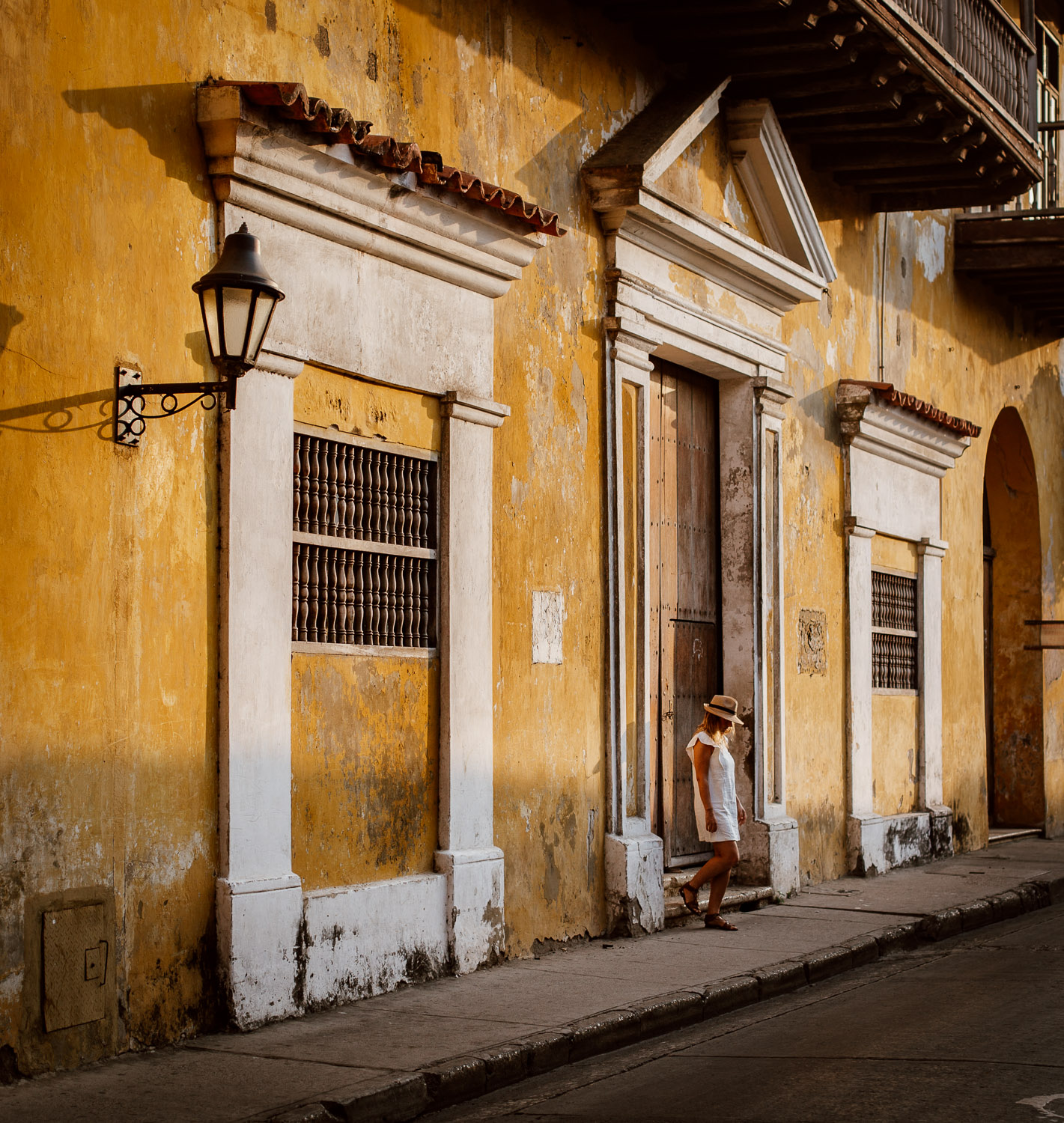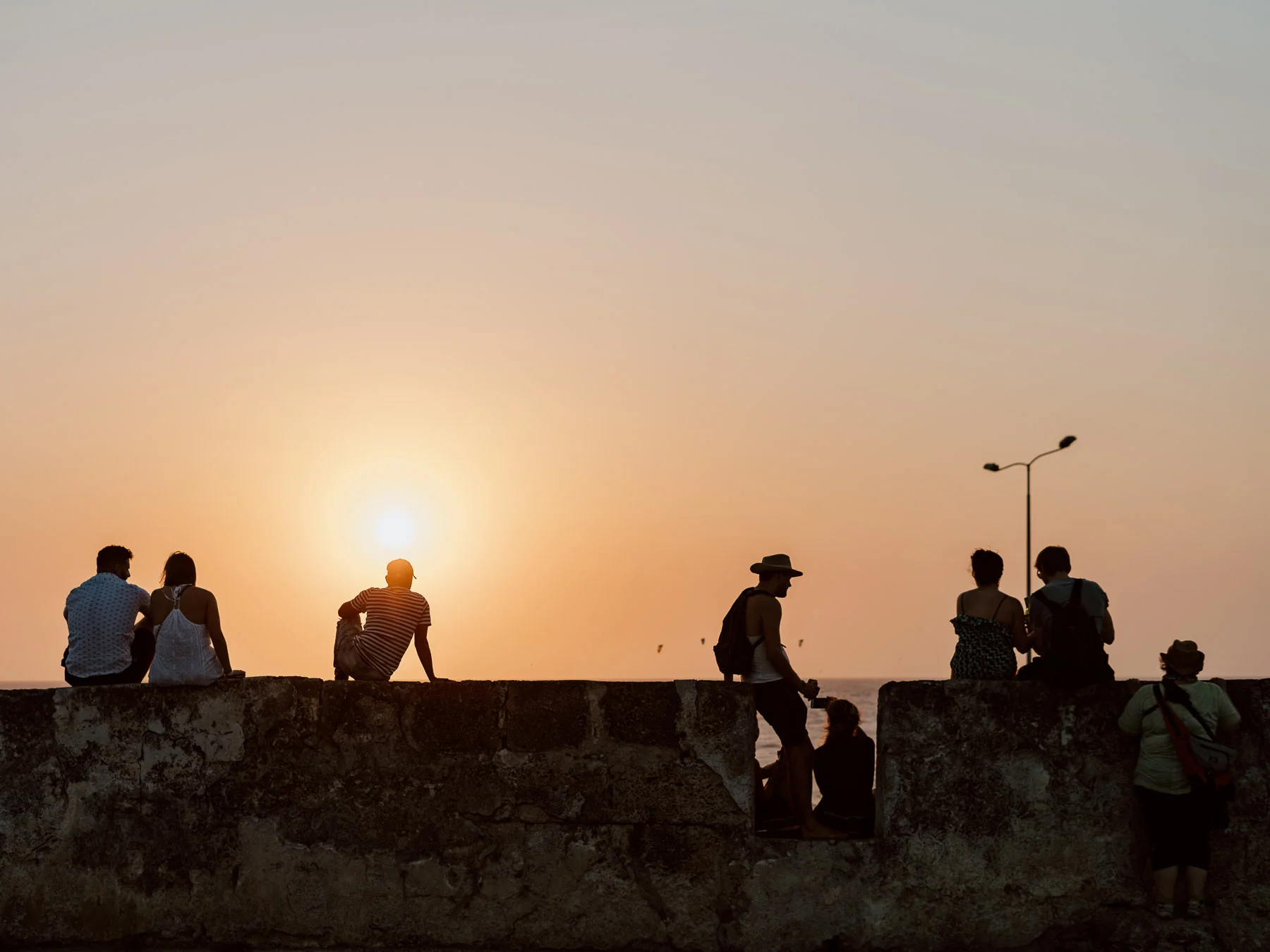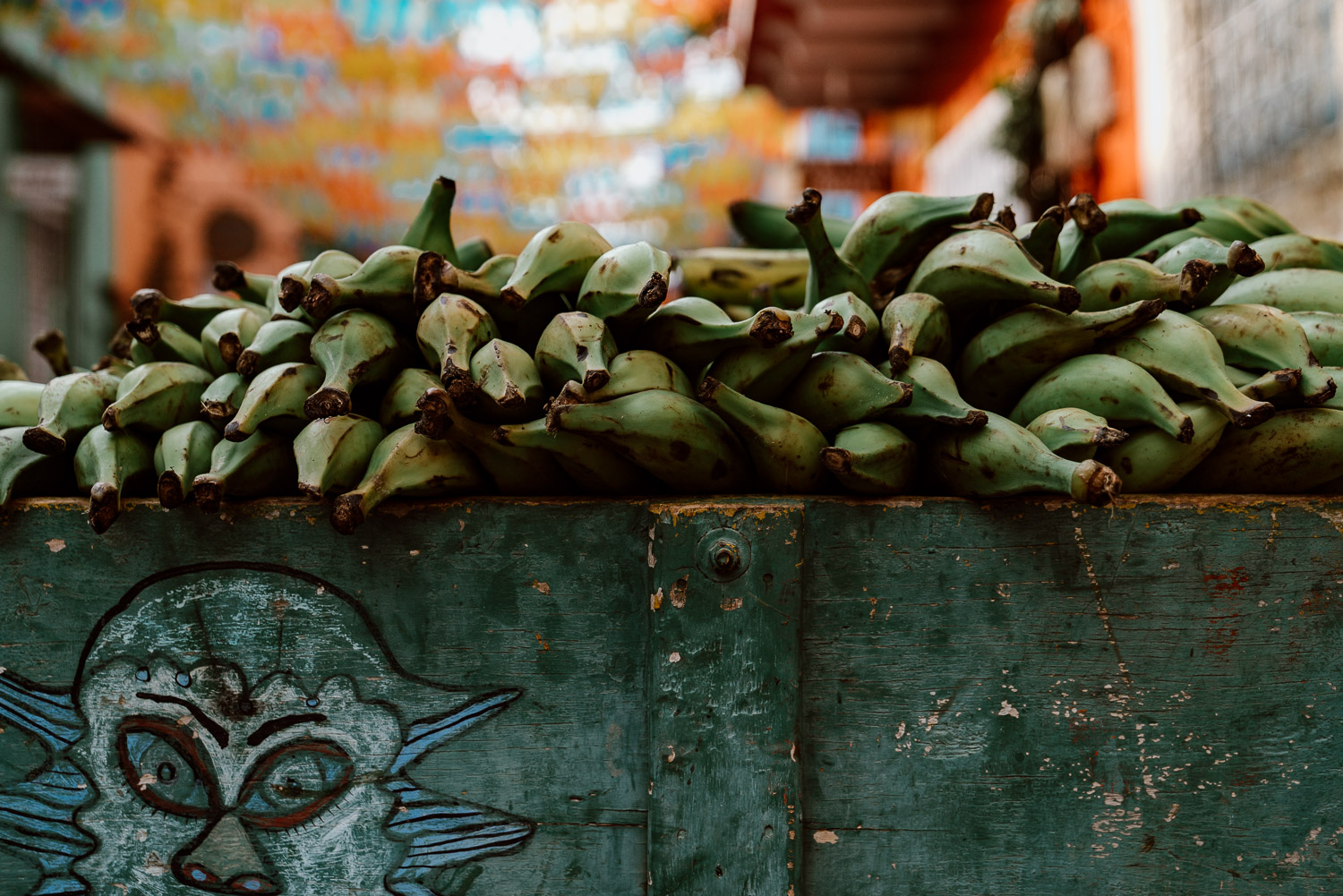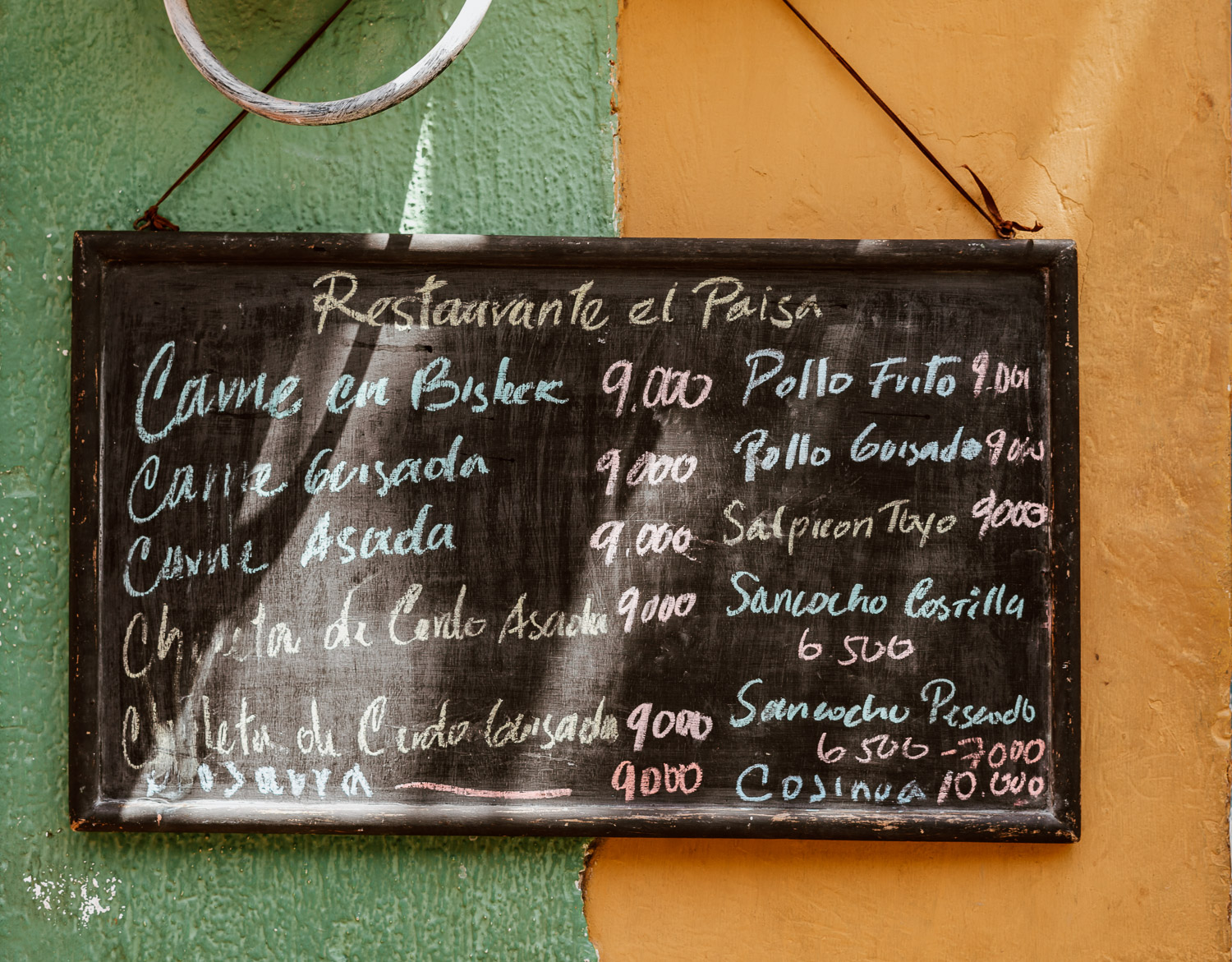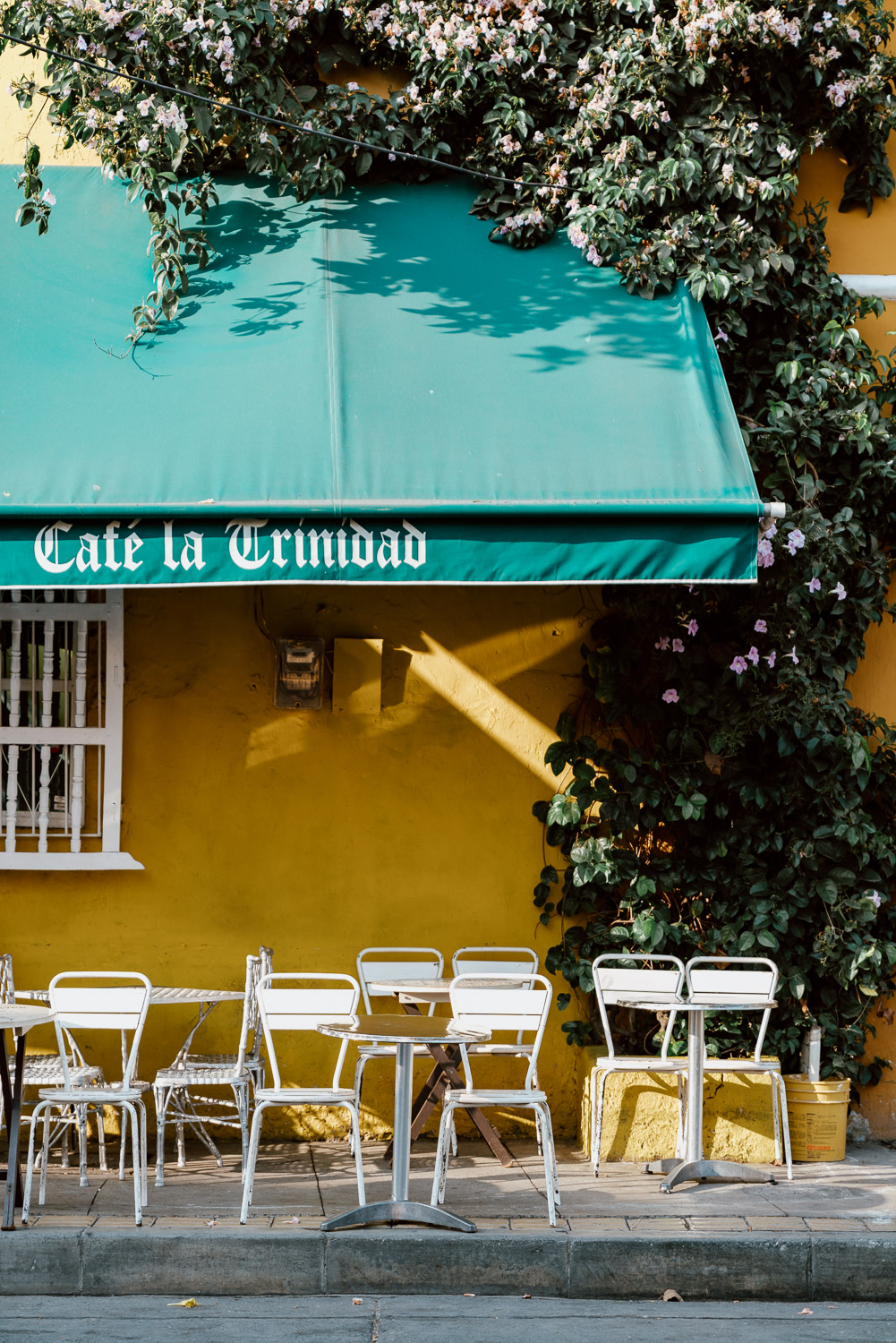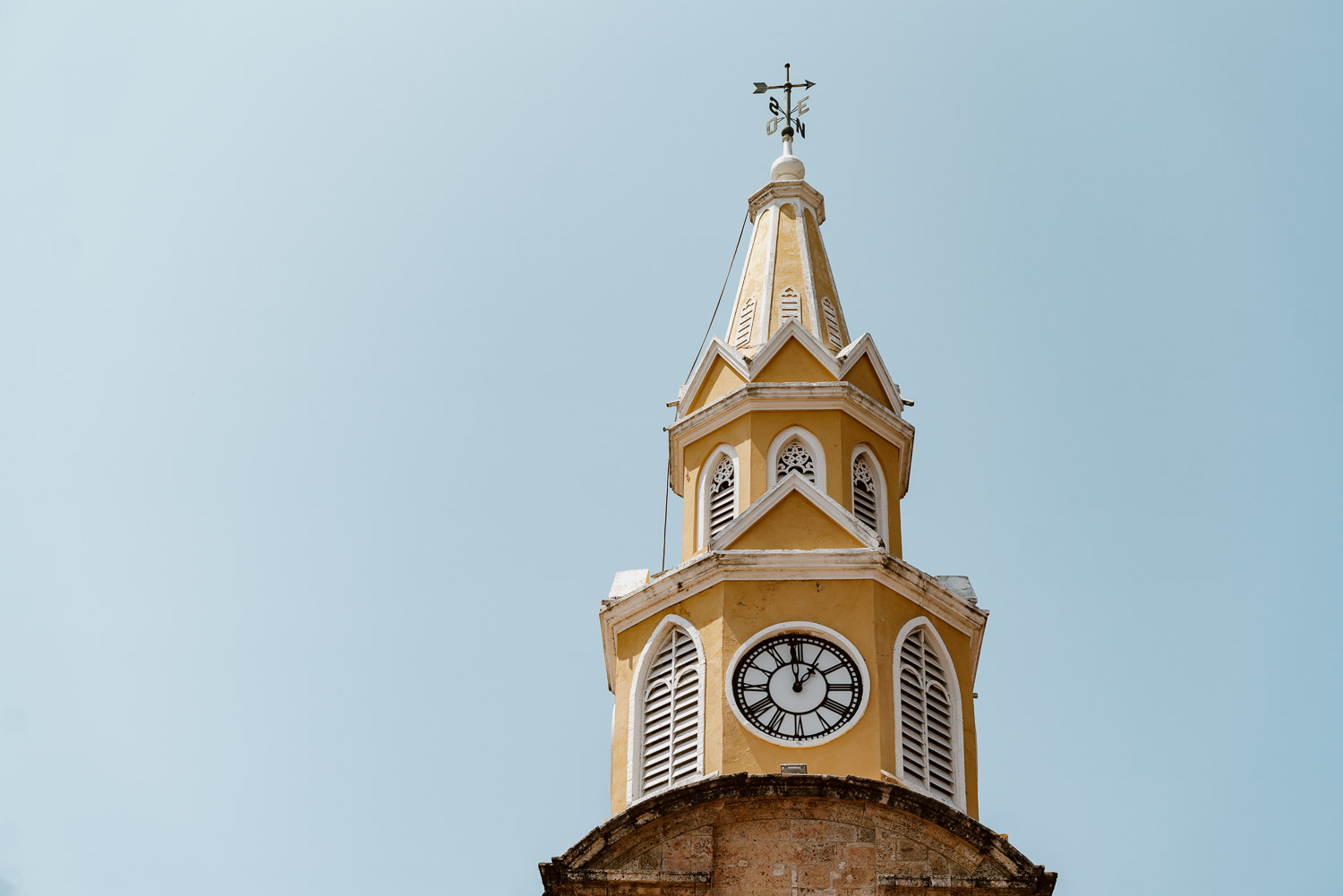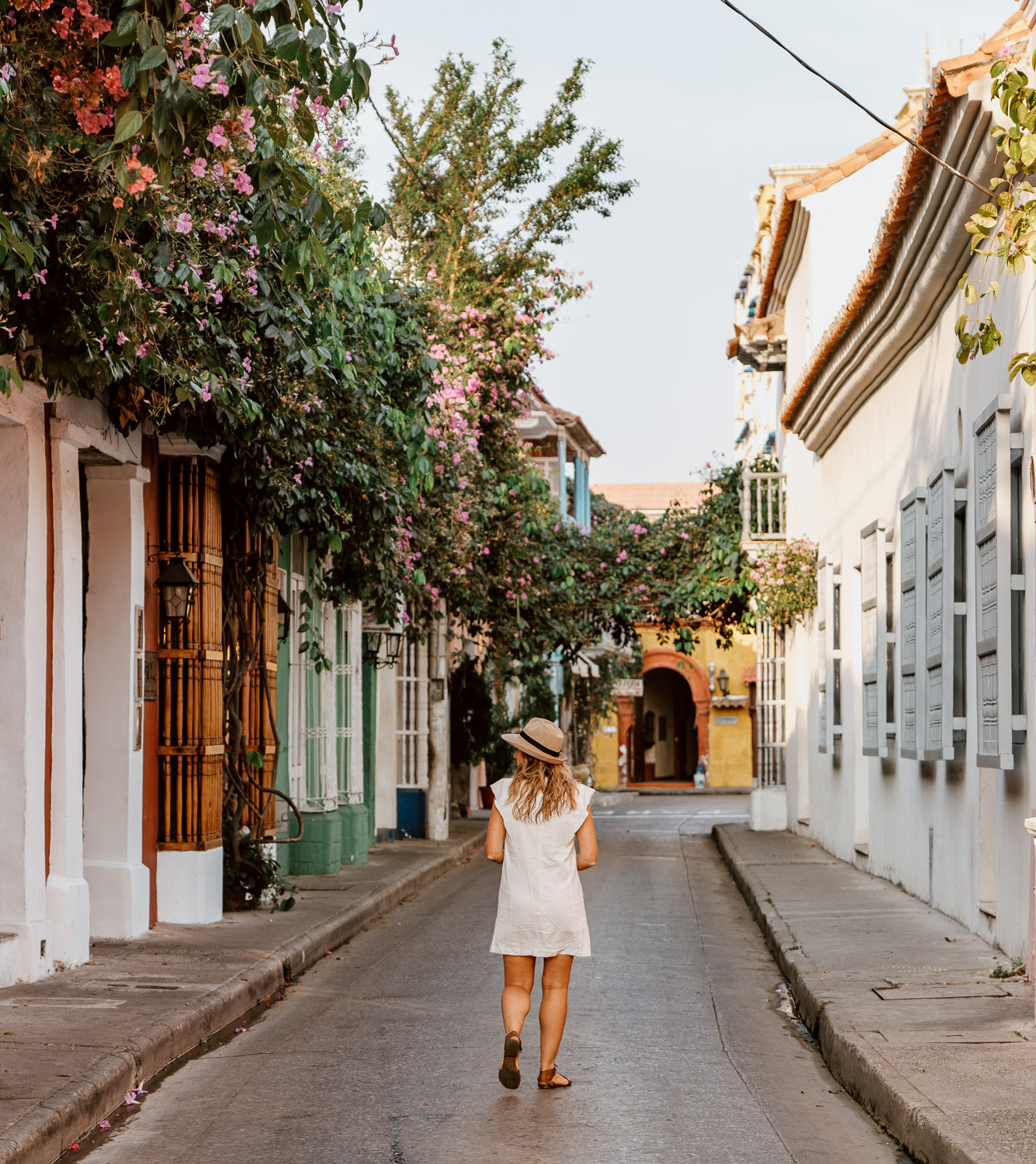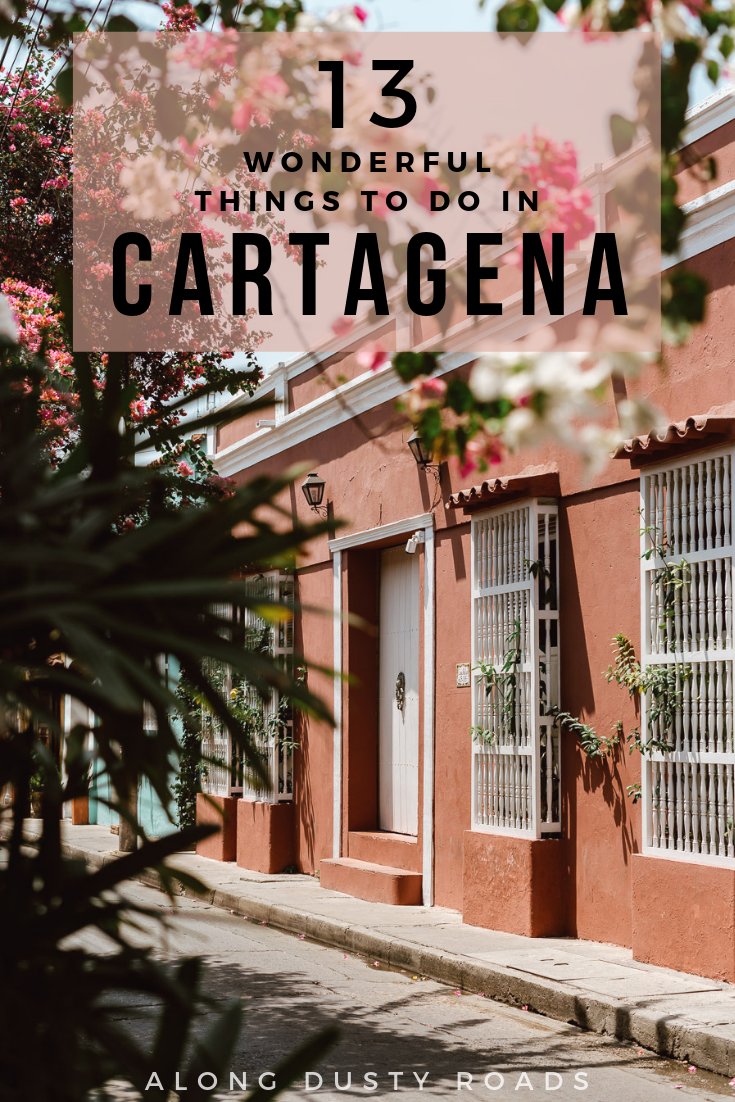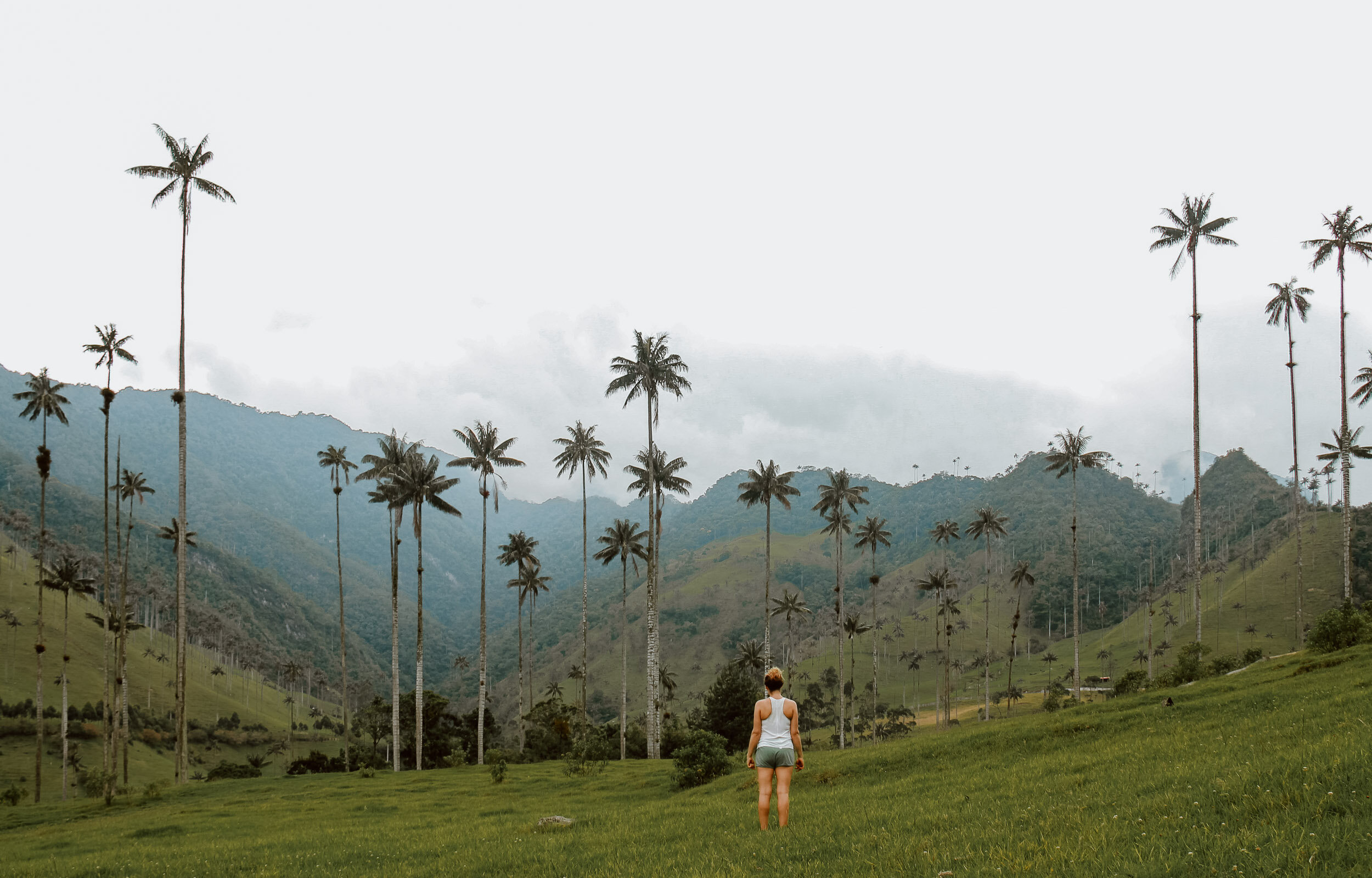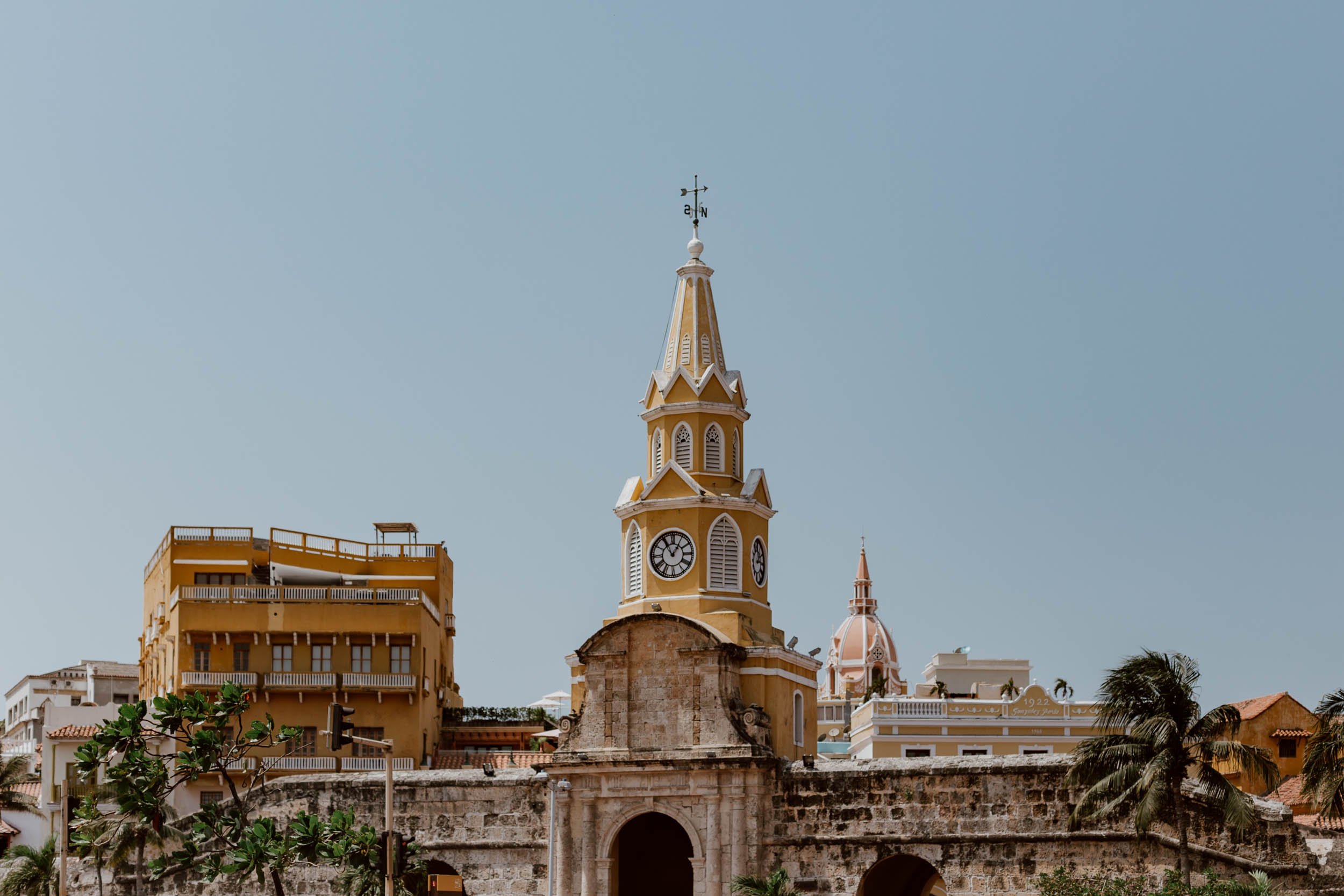The beautiful walled city of Cartagena is a must stop on any Colombia itinerary, and in this guide you’ll find everything you need to plan the perfect trip. These are the most wonderful things to do in Cartagena.
Updated | September 2023
Cartagena is a city which gets under your skin almost instantly.
Its crumbling walls of yellow, red, and blue, are perhaps the most photogenic we’ve ever seen in South America.
However this beauty goes to another level when juxtaposed with the endless street scenes which unfold before you when exploring this impossibly hot Colombian city. There’s the old man selling mangoes and watermelons in front of the tango club, family barbershops full of laughing men, a spontaneous street band playing on Carrera 10 under billowing flags at sunset, the woman making fresh fruit juices in front of the old banana-yellow church.
The city has, undeniably and unequivocally, seen a lot of change in the last decade. Much of this is positive, a bellwether that Colombia’s position as a safe country for travel has now spread outwith the backpacker network. However, Cartagena is also starting to become a victim of its Instagram-and-word-of-mouth fuelled success; on our two trips to the city across four years, the scale and pace of its tourist transformation really did take us by surprise.
Yet a destination which ebbs and flows between being the inspiration for many of Garcia Marquez’s dreamlike creations and the poster child for the opportunities of tourism in the ‘new Colombia’ is never going to be jettisoned from itineraries covering our favourite country in South America - whether you’re travelling Colombia for a few weeks or a few months.
To help you have the most memorable time in the city, here are our favourite things to do in Cartagena, including insider advice on where to stay, how to find an insight into authentic Colombia, and some of the best places to eat and drink.
The Cartagena Essentials
Arrive / A 45-minute taxi ride from the bus station, or a pre-booked transfer from the airport.
Stroll / The colourful streets in the Getsemaní neighbourhood (or discover its famous street art on this excellent walking tour) and the beautiful historic centre.
Cafe / Drink the best coffee in the world - we loved Cafe Mural
View / Enjoy the famous sunset from the ramparts or escape the crowds on this golden hour boat tour
Eat / Local, delicious fruit, juices and snacks can be found on street stalls
Tour / Bazurto market to discover Cartagena on a sensory level
Party / Grab a drink in Plaza de la Trinidad, grab an excellent cocktail at Alquimico or dance the night away in a salsa club
Stay / Backpackers will love Life Is Good Hostel, Amarla Boutique Hotel will suit vacationers who want to splurge, and there are loads of excellent Airbnbs - this one-bed is a great affordable option, but if you’re travelling with a large group for a special occasion, this one is gorgeous!
13 Wonderful Things to Do in Cartagena
Explore The Streets of Getsemaní
If something has drawn you toward Cartagena, then it’s likely to be a photo of one of its many, many, colourful streets.
Although there are no shortage of these dreamy kaleidoscopic calles and carreras within the Walled City (more on those later), we largely preferred those we found ten minutes walk away in and around the Getsemaní neighbourhood.
Once the grungy, gritty, salubrious part of old Cartagena, Getsemaní evolved into the hub for backpackers and curious travellers in the last decade. However, it was clear on our most recent visit that gentrification and wider tourism have now also arrived here in spades. Although homeless men still sleep in one section of the painted street off Plaza de Trinidad, which was unlit and avoided for years, that section is now also home to a cool Italian restaurant, cocktail bar, and visitors strolling to or from some of the various boutique hotels nearby.
The invisible barrier between Getsemaní and the historic walled tourist centre of Cartagena has become so blurred, that it almost no longer exists, and the pace of development is clear. Its punk spirit is fading quickly, being replaced by the modern and hipster-friendly aesthetic of new Cartagena within the crumbling, colourful colonial walls.
And yet, it remains our favourite part of Cartagena (we’re also suckers for that hipster-friendly aesthetic, so totally get that we’re part of the problem!) and, for our money, it’s still home to the prettiest and most atmospheric nooks and crannies of the city even if those nooks and crannies are less and less populated by various generations of families.
If you explore in the early morning or with an open mind off the main streets, you can still find moments and snapshots of the old Cartagena.
Some of the more popular spots and tourist attractions include:
Callejon Angosto. Also known as ‘the umbrella street’, this is a popular insta-spot - (as well as being somewhere the locals still very much live, so be respectful). Find it here on Google Maps.
The street art. Such a intrinsic part of the Cartagena experience, this has its very own section below.
Plaza de la Trinidad is the bustling street in the heart of Getsemani. Busy with food carts, juice stalls, people watchers, bars, restaurants and a wonderful frenetic energy at all times of the day, it really comes alive at night when revellers meet and party in its very centre. Find it here on Google Maps.
Travel Tip // If you’re flying into Cartagena and it’s your first time in the country, then it’s a good idea to book a private airport transfer online before you arrive to bring you straight to your hotel.
Street C-ART-agena
Apologies for that terrible pun, but it’s at least better than Andrew’s preferred option of ‘A Street C-ART-agena Named Desire’.
Ok, they’re both equally terrible.
Colombia has actually become a bit of a mecca for graffiti artists, and though Bogota is the undisputed epicentre for this (weirdly due to Justin Bieber), Cartagena’s walls are home to some of our favourite works
The Indian girl on the doorway, the beaming Afro-Colombian woman with streamers for hair, the masked group of children staring down at you with menace or glee, giant blue birds, and towering pieces of photograph-like art that appear seemingly out of nowhere.
Evidence of an artistic revolution that walked hand-in-hand with the gentrification of Getsemani, the canvas for so many of the city’s artists.
Many of these works will reveal themselves to you as you stroll through the streets, and share stories indelibly linked to the story of the neighbourhoods, their most famous sons and daughters, and the city’s past and present, but we’d recommend making a point to stop by the spots:
Calle 29. Also known as Calle de la Sierpe, this was one of the first streets reclaimed by local street artists, and the vast majority is now covered in large scale pieces. Find it here.
Calle de San Juan (maps).
Plaza de la Trinidad (maps)
Las Tres Guerreras (The Three Warriors) at the entrance to Santuario Hostel. A piece so hypnotic, towering, and well-executed, that you simply have to seek it out. You can read more about the artist and the piece here and find the street art here.
With street art figuratively woven into the fabric of Getsemani, if you have the time, joining a tour with an expert is one of the best things to do in Cartagena and a great way to gain a better understanding.
This two-hour group tour includes a guided walking tour of Getsemani alongside insider explanations and stories of the street art and artists, and a chance to visit local art galleries and studios. Find out more here.
Read More | You can see more of Cartagena’s street art in this post
Brunch At Cafe Stepping Stone
Update 2022 | Unfortunately the pandemic was not kind to Cafe Stepping Stone and it has closed its doors permanently. It’s a big loss to the city, and the people it helped.
We had been travelling for three months in South America, and so were hankering for some decent brunch and a lazy morning catching up on news on our first morning in Cartagena. We strolled down Carrerra 10, which has always been a go-to place for backpacker-friendly eats in Cartagena, and saw that much had changed; mostly for the better.
The blackboard menu at Cafe Stepping Stone drew us in with its promises of smashed avo, homebacked sourdough, and flat whites (yes, we recognise our hypocrisy right now given the hipster rants, but we did at least admit that we’re also suckers for it?!)
The brunch and atmosphere was so good, we went back twice. However, it’s also the ethos and work that Stepping Stone’s three young Australian founders are doing which really makes it stand out amongst the rest.
It’s a social-enterprise cafe which employs and trains local disadvantaged youth, with the cafe providing them with skills, confidence and opportunities to gain future employment and change their lives. They have had a really good first two years, with positive results for those they are aiming to help, and they share everything transparently over on their website too.
So, go for the brunch and great coffee, go again to help them create better opportunities for many.
Walk the Walled City
There’s actually not a lot to do in Cartagena; it has a few museums, a couple of activities and sights, but none that are world-famous or absolute must sees like Rio de Janeiro, Buenos Aires, Cusco.
This is not a bad thing.
It means that the main attraction is the city itself - its film-set pretty streets, its living history, its characters and charmers, its nightly rhythm to the sounds of salsa, the fumes of aguardiente, and sizzling steam of street food carts. It’s a place for you to come and explore and learn and be curious, but then to relax in the sunshine, with a cocktail in a plaza, a freshly brewed coffee, or to have your first taste of Colombia’s infectious joie de vivre.
La Ciudad Amurallada, or the Walled City, is where most of this will be done and where the vast majority of non-backpacking visitors to Cartagena will stay. These walls, a UNESCO World Heritage site, remain standing strong long after they were erected and their purpose has expired (their primary role was to support the Spanish conquistadors in defending their first colony in the Americas against others looking to loots its riches).
Did you know? // In the 16th century, the drawbridge would raise from the city walls every evening at 6 p.m., separating wealthy Spanish families on the inside from slaves and workers on the outside.
Fast forward to the present day and the streets inside the Walled City have become a major attraction, overflowing with tourists from mid-morning onwards (the increasing number of cruise ships and their passengers don’t help either). The very best way to see them therefore is by rising early before the rest of the city wakes; this is how you’ll capture photos of empty streets but also offers a slither of time to imagine how La Ciudad Amurallada looked all those years ago.
If early mornings aren’t your thing, or you’re only in the city for a short while and need to maximise your time, chuck on a pair of comfortable shoes, slap on the suncream, and explore the back streets to find its most charming corners, impressive structures, and secretive lanes over the course of a day.
Some of the historical highlights you should make a point of passing include:
The Clock Tower (or Puerta del Reloj) | Sitting at the original entrance to the fortified city, the 17th century lemon-yellow clock tower is an excellent place to begin your wanderings of the historical centre. Find it here.
Cartagena Cathedral | One of the city’s most iconic landmarks, you’ll have seen countless images of the cathedral’s yellow tower and terracotta dome before visiting - in person, it’s just as beautiful. Looking for the best photo of it? Head to Calle Don Sancho or Calle de la Iglesia. Find the cathedral here on Google Maps.
Santuario de San Pedro | Founded by the Jesuits in the 17th century, it later changed its name to honour a monk by the name of Pedro Claver who spent his life ministering to African slaves. Inside, there are a series of paintings within the church telling his life story, and his remains are kept in a class coffin in the altar. They have a slightly complicated pricing system, so we’d recommend heading over to the official website for further details. The church can be found here.
Palace of the Inquisition | One of the city’s prettiest colonial buildings, but an appearance that belies its former use as a place of torture for the Spanish Conquistadores. It nows functions as a slightly gruesome museum, displaying torture instruments like the rack, the head crusher and other terrifying means of extracting a confession. It’s open every day, costs COP$23,000 (a price that some visitors say is somewhat inflated) to enter and can be found here on Google Maps.
It is important to note however that much of Cartagena’s history and its favourite stories are found behind the grand doors of its churches and colonial homes (look out for those fantastic knockers by the way), underneath its yellowed arches, vaults, its colourful cloisters, and between the looks of strangers; discovering these streets by foot will allow you to appreciate the city’s beauty, but to truly understand its past, and the tales weaved into it, we’d recommend joining a walking tour.
This three-hour group Walled City Walking Tour (including entrance to San Pedro Claver Church and the Inquisition Palace) has excellent reviews, or if you’d prefer a private tour, this four hour option - which includes many of the city’s other sights - is also highly-rated.
TravelTip // Each time we’ve been in Cartagena, we’ve made a beeline for one of the delicious artisan icicles (paletas) and ice-creams from La Paletteria in the walled city (Calle 35 #03-86, find it here on Google Maps) - they’re perfect to ward off the Cartagena heat!
The Walled City is also home to Cartagena’s best artisan stores and boutiques, so if you want to shop, this is the place.
Take A Day Trip to The Islands
You may be wondering why we haven’t yet mentioned any of the beaches in Cartagena? After all, this is a city right on the Caribbean sea so surely it’s got to have some!?
However, it’s important to know before you arrive that Cartagena really isn’t the place to come for a beach holiday or to enjoy tropical vibes. Yes it has a handful of city beaches (such as Bocagrande), but they are likely not what you’re hoping or planning for.
However, the good news is that it’s very easy to access several excellent postcard-worthy beaches on a day trip from Cartagena!
Isla Baru & Playa Blanca
The classic Cartagena day trip.
Isla Baru is now connected to Cartagena by road, and many visitors to the city pair exploring its beautiful colonial streets with a morning and afternoon on the narrow white sand beach on this island.
Playa Blanca’s water is a gorgeous blue, and though the beach does become very busy with locals and tourists on weekends and in high season, during the week it’s still a decent option if you want to enjoy a fresh fish lunch, sip on a cocktail or cold beer or two, top up the tan and have a dip in the ocean.
You can find instructions on how to reach Playa Blanca with public transport here, or for a day trip without the fuss, consider joining a small group, full-day tour like this one which includes hotel pick-up, round-trip transport, and lunch.
The Rosario Islands
Declared a national park in 1988, the 28 Rosario Islands are a mixture of those open to the public, those left to nature, and those owned by wealthy Colombians. However, the two largest islands - Isla Grande and Isla del Rosario - are arrival and jump-off points for tours and independent travellers. As well as being home to a few resorts and hotels, these verdant palm-tree islands in the Caribbean Sea are perfect for snorkelling in the clear blue, a more secluded peaceful beach experience than on Playa Blanca, and a slice of nature.
To reach the islands independently you’ll need to hop on a speedboat from El Muelle La Bodeguita (not far from the Walled City’s clock tower) - you can find further details on making this journey in this blog post.
Alternatively, this exceptionally popular and highly rated tour transports you into the Caribbean on a catamaran, for a a full day on white sand. Includes lunch, snorkelling equipment and national park fees.
For more information, read this post on the 6 Best Day Trips from Cartagena.
Taste Proper Colombian Coffee
The best coffee in the world is from Colombia. Full stop, no arguments.
Its chocolate and caramel rich aromas are simply wonderful, and any visit to the country should involve a little bit of tasting its most famous (legal) export. Cartagena doesn’t have as many of the truly excellent specialty coffee shops which can be found in Medellin, Bogota, and in the towns of the Coffee Triangle, but if you are only visiting the city and the Caribbean coastline, then you should make a beeline one morning to sup on some of the good stuff (or for a break from the Cartegena afternoon heat).
Juan Valdez is the Starbucks of Colombia and you’ll find a few of these in the Walled City, but your best bet to taste single-source beans from the regions and enjoy a good atmosphere are:
Cafe Mural | Down the graffiti-heavy Calle San Juan side street in Getsemani, this small but lively coffee shop is actually only open in the public from 3 p.m. - 8 p.m. as they provide private coffee classes and tastings in the morning. A place for coffee lovers and those who want to learn about it. Find Cafe Mural here on Google Maps.
Ábaco Libros y Café | A contrast with much of Cartagena, this cafe and bookshop feels more like a Harry Potter hideaway. Find it here on Google Maps.
Epoca Espresso Bar | Located within the walled city, this is a fairly upmarket coffee shop and bistro (think black and white tiled floors, black furniture and high ceilings). Excellent coffee and fancy brunches. Find it here.
Libertario Coffee Roasters | A place that really knows its stuff (they’ve actually got three shops in Bogota and ship internationally), they offer a variety of different coffee filter systems as well as your standard espresso based drinks. Throw in a cool aesthetic and a place you want to hang out and it’s a must-visit for people who love their caffeine hit! Find it here on Google Maps.
Folklore Cafe | A large cafe close to the Clock Tower, its walls explain coffee production in Colombia and you can taste seasonal single-origin beans from the key production areas in the country. Servce V60s and Chemex as well as standard espresso-based drinks. This cafe appears to have recently shut down, but we’re leaving the details here in case - and in the hope - that they may re-open in the future.
We absolutely loved Gato Negro, but alas it seems to have been another casualty of the pandemic.
hop On Gabo’s Trail
If you have never read Gabrial Garcia Marquez before, then your trip to Colombia is about to get a whole lot better.
Seriously.
Colombia’s most famous author grew up and spent a great deal of his early life in Cartagena, and much of his inspiration was drawn from the city.
“All of my books have loose threads of Cartagena in them...and, with time, when I have to call up memories, I always bring back an incident from Cartagena, a place in Cartagena, a character in Cartagena”
So, if it’s your first time in Colombia, we highly recommend you make reading one of his best works a big part of your pre-trip planning process!. Not only are they wonderful, but they will transform how you see and interpret the world on your strolls around Cartagena.
We recommend you start with One Hundred Years of Solitude (our favourite) or Of Love and Other Demons (which is set in Cartagena).
Travel Tip // If you’re already a fan of Gabriel Garcia Marquez, then you can take this literary tour around the city focused on his works and his words.
Additionally, book lovers should take a stroll through Parque Cenetario in the late morning or early afternoon; the large park between the Walled City and Getsemani is home to various bookseller stalls, or if you are still planning your time in Consider, consider coinciding your time in Cartagena with the Hay Festival, a four-day literary and cultural even that takes place between the end of January and the beginning of February.
enjoy Sunset on the Ramparts
You may have read that sunset on the old ramparts is a must-do in Cartagena - and we totally agree.
However, you may also have read that it’s best done from a table at Cafe del Mar? Well, we’re here to tell you that that’s nonsense.
It may have been the case five or ten years ago when Cartagena was still very much under the radar, but now Cafe del Mar (Google Maps) is hideously oversubscribed at sunset, with far too many people to make the experience truly enjoyable.
So instead, our alternative recommendation to enjoy the Cartagena sunset over the sea is to arrive at the old wall ramparts either side of Cafe del Mar an hour or so before the sun starts. Come armed with drinks and snacks (or buy a cold beer from one of the entrepreneurial vendors that walk the ramparts from the early evening onwards), and settle into one of the many gaps in the walls.
Not only will this save you a few pesos, but it’s far easier and much more romantic (which if you’re a backpacking couple staying dorm beds, might make a nice change!).
Alternatively, if you are looking for something a little different and want to enjoy the sunset from an extra special vantage point, consider this highly rated two-hour sunset cruise or this 90 minute experience that also includes an open rum bar!
VISIT BAZURTO MARKET
If you’re a foodie or want to see a slice of Cartagena proper, then head out to the chaos of Bazurto market for a morning.
We love visiting local markets wherever we go in South America, and Bazurto delivers on all sensory levels. From exotic fruits you won’t find anywhere else, to a bizarre conflagration of meats, fish, and spices; it’s an experience all on its own and a must for the cultural and curious traveller.
You can find the market here on Google Maps, just 15 minutes from the Walled City. To reach Bazurto, we’d recommend grabbing a local taxi for which you can expect to pay around COP$10,000 (if anybody has made this journey recently and can confirm the price is correct, we’d love to hear from you in the comments). Do note that there are some scare stories online about this place with regards to security. Yet whilst pickpockets are definitely a problem, as long as you use common sense and don’t bring all your valuables, you should be absolutely fine.
Alternatively, first-timers in Colombia or non-Spanish speakers may prefer this excellent small group tour which aims to follow in the footsteps of Anthony Bourdain when he visited Bazurto Market as part of his No Reservations show. Includes transport, fruit tasting, guide and a four-course tasting lunch menu in the market. Find out more here.
Eat Local + Try Colombian Street Food
There are so many new restaurants popping up in old Cartagena, and most of these are very focussed on the international market and palette. You really won’t struggle to find somewhere you like.
However, to give you some insight into day-to-day Colombian life, we highly recommend that you go out of your way to spread your spending and support the livelihoods of lifelong residents who may not be directly benefiting from the rapid change Cartagena has seen.
So, make sure to eat lunch at one of the remaining small, local restaurants. Atmospheric, cheap, affordable, and delicious, they all put on a menu del dia each day, which is a fixed two-course lunch menu plus a fresh juice for as little as 8,000 COP (£1.8 / $2.5). Our particular favourite which we’ve visited each time in Cartagena is on Carrera 10 in Getsamani and does the best sancocho de pescado (Colombian fish soup) we have ever tasted. It’s easiest to find if you search for Malagana Cafe & Bar, and it’s literally opposite!
Next up, make a point as a traveller in the city to purchase fresh mangoes, avocadoes, bananas, and all manner of other fruits which only exist in Colombia from the men and women with street carts. They’re all over the city, but you’ll find a lot on and between the busy streets of Avenida Venezuela and Calle 32 which split Getsamani and the Walled City in two.
Similarly, slurp on one of the fantastic fresh juices which are also sold on various carts and a few local stalls at Parque De Las Flores. We became quite addicted to cold Lulo juice and Maracuya juice during our time in Colombia and you should go out of your way to try either at least once in here! Emily would always have hers with just water, Andrew would sometimes take the milk option with a dash of sugar, so take your pick!
Lastly, have your first taste of arepas - the very traditional Colombian staple. You can buy bags of them from the supermarket and simply slather them with avocado, indulge in a heart-attack inducing arepa con queso from one of many carts on the street, or tuck into a stuffed arepa from the stall on Carerra 10. It’s also possible to join a cookery class to learn to make them yourself!
If you’d be keen to join a cooking class, but would prefer to expand your Colombian repertoire to food such as sea bass ceviche, seared beef, and coconut rice, consider this popular small group cooking class (alternatively, if you prefer to stick to just rum and chocolate - absolutely no judgement from us! - this group tour may be perfect for you).
Street tours more your things? Check out this super popular and highly tour around Corralito de Piedra where you can learn about local history while enjoying local cuisine.
Travel Tip // If you’re staying in a hostel with a kitchen in the Walled City or Getsemani, then doing your shopping at the large air-conditioned Éxito supermarket on #9 Avenida Venezeula (maps) or nearby Supermercado Olímpica La Matuna (maps) is the most convenient option for everything else.
grab A Drink in Plaza de la Trinidad
Plaza de la Trinidad (maps) is our favourite hangout spot in Cartagena, and we spent many a late afternoon there sipping on cold beers watching the world and men wheeling carts go by. Though its tables are now more populated by fellow gringos than locals, and English is the language carried in the breeze, it’s still a lovely spot.
You can’t go wrong with a pavement table on the corner at Solar (maps), whilst the newer, hipper, colourful Palenqueras restaurant / bar on the other side of the square serves a mean cocktail (find it here).
In the evenings, Plaza de la Trinidad transforms into a more raucous, social street party (especially on Friday and Saturday nights). Musicians, clowns, street dancers and performers, street food carts, and hundreds of locals and visitors cluster together in the small square for good time. With the big increase in visitor numbers, we felt it was close to becoming a little too oversubscribed, but it’s doubtless still authentic at its core with just as many locals as gringos.
Travel Tip // The streets of Getsemani are very busy and social at night, but if you want to escape to a less salubrious spot in the evening, then go to Basilica (Cra. 26 #25-78, find it here). Its pizzas are bloody marvellous, and the triangular little square is filled with live music and couples dining outside in the lingering warms air. Nearby Carrera 10C (maps) is also a good shout for evening cocktails and dining, but its options are definitely a little classier.
Party & Dance
As the heat dies down, Cartagena comes alive and a big part of being in this city is enjoying its nightlife scene, in and beyond Plaza de la Trinidad.
Cafe Havana (maps), Quiebra-Canto (maps), Donde Fidel (maps) are classic and best options for salsa, whilst there are a bunch of hostels down Calle 30 in Getsemani (these are all nearby eachother) for backpacker evening beers.
For a more upscale evening, be sure to check out the award-winning Alquimico. Staffed by excellent mixologists, they use local ingredients, grown on their organic farm in the Colombian countryside and serve up the sort of cocktails that have you going back again, and again. Find it here on Google Maps.
Learn how to dance like a local at this dance class at a secret rooftop of the old city, alternatively this small group tour takes you to the best local bars in Cartagena, start with laid back atmosphere with sea and city views before heading to more lively areas.
Travel Tip // You may see horse carriage rides being offered in the city. We would implore you to please not do these as the horses all looked to be in really quite terrible condition. You may think that the only way to improve their condition is by giving their owner more money, but it’s clear that this doesn’t go towards the horse’s welfare.
Enjoy the Best Views of Cartagena
Before telling you the best places to stay in Cartagena and our essential travel tips for the city, you need to know that the last thing to do for a perfect visit to the city is to savour some of the best views over it! These can be found at:
Castillo de San Felipe de Barajas
San Felipe Castle for short, this fort was built by African slaves in 1657 to protect the conquering Spanish against pirates and rivals. The history of this city is so interwined with slavery and colonialism, and taking a walking tour is the best way to undersatnd this history. However, the castle itself remains a much-visited site in Cartagena and is a popular alternative for sunset (although it closes at 5 p.m.) and impressive views of Cartagena.
It’s just outside Getsamani, or a 10-minute walk from the Walled City’s clock tower, here on Google Maps. Entry is 30,000 COP for adults, 15,000 COP for children and tickets can be bought online or at the castle.
Movich Hotel
If you’re lucky enough to stay at one of the many hotels with a fantastic rooftop and the accompanying great views, you can move on to the next section. For everyone else however, you’ll be pleased to know that non-guests are able to access the rooftop bar at the luxurious 5* Movich Hotel at any time of day. You can find the hotel here.
Convento de la Popa
On the highest hill in Cartagena, this pretty 17th century convent provides a panoramic view out over the city, and allows visitors to fully appreciate just how far Cartagena extends beyond the historic centre.
Unfortunately, with no public transport connections, and a somewhat dicey walk through a dodgy neighbourhood, the only way to reach it for the independent traveller is with a pricey taxi (expect to pay up to $15 USD).
If you’re super keen to visit the Convent, consider joining this tour which includes it as one of the stops.
Where To Stay in Cartagena
Most visitors staying in Cartagena fall into three camps: those backpacking for a month or longer in Colombia, those who are visiting for a two-week vacation in the country, and those who are taking advantage of cheap new flight connections with the US to spend their time solely in and around Cartagena.
Obviously, there are a lot of different budgets and travel styles to cater for there, but Cartagena does offer something which suits everyone. Many homes and old buildings in the Walled City have been transformed into Conde Naste-style boutique hotels, whilst nearly every other building in Getsemani seemed to be a recently opened cool hostel or Airbnb apartment.
However, before you arrive, it’s essential to understand that prices for accommodation in Cartagena are notably higher than elsewhere in Colombia and - with more and more visitors each year with all sorts of budgets - there is very high demand. If you know that you’re going to be visiting Cartagena soon or in the next few months (especially in December - April), it is absolutely essential that you book ahead.
Hostels in Cartagena
Viajero Cartagena | A Cartagena classic, this is a great option for solo backpackers and groups looking for good value dorms in a social hostel - check prices here.
El Barrio | One of the best value options for couple in Cartagena looking for a private double in a good hostel - check pricing and availability
Life Is Good Hostel | It doesn’t have many doubles, but it’s a bloody great hostel with a guest kitchen and rooftop with two jacuzzis! Good value dorm beds too - take a look.
If your budget isn’t so tight, you’re looking to enjoy one of great new hostels in the city, or you want to see some alternative options for inspiration, then this post on the Nine Best Hostels in Cartagena is essential reading and gives an overview of hostels prices you can expect.
Boutique Hotels in Cartagena
If you’re visiting Cartagena for a more stylish, luxurious or romantic experience, then you will be able to choose from a fantastic selection of boutique and bespoke hotels in the Walled City - many also come with rooftop pools!
We’re putting together a little guide of our top boutique hotel recommendations (out soon, we promise) but until then take a look at a handful of our top picks:
Ananda Hotel Boutique | La Passion | Hotel Casa del Arzobispado | Amarla Boutique Hotel | Casa Pestagua
Airbnbs in Cartagena
Unsurprisingly, there are now a growing number of stylish and affordable Airbnb apartments in Cartagena. You can view our personal selection of the the very best Airbnbs apartments in the city here (including two absolute gems for under £50 a night).
cartagena transport
Cartagena Airport
Both international and domestic flights will arrive to Rafael Nunez Airport (CTG) which is weirdly in quite a residential area of the city. From there you can queue up to take a taxi which will cost $15,000 COP - $25,000 (the price is fixed depending on which zone you go to but the standard cost to get for the historic centre of Getsemani is $17,400 COP).
Alternatively, if your Spanish is limited and you prefer the comfort and convenience as you arrive for your first time in Cartagena, you can easily book this good value private airport pick-up service online (this transfer can also be booked on Viator).
Cartagena Bus Station
If arriving into Cartagena from elsewhere in Colombia, then you should know that the main bus terminal is 45-minutes outside the historic centre - find it here on Google Maps.
Thankfully, you’ll have no issue finding a taxi out front to take you to your hostel, hotel or apartment. Prices are fixed and clearly indicated on a sign to specific zones in the city - just make sure that you confirm the price and zone with your driver before you set off.
To any accommodation in the walled city or Getsemaní expect to pay around COP$25,000.
Alternatively, you can take the TransCaribe bus (route X104) for $2600 COP. Find the bus stop at the Centro Station and then ride it all the way until the end. The public bus system is relatively straightforward to use, but we would advise against taking this bus if arriving later in the evening.
We have shared everything else you need to know plan and prepare for your trip to Cartagena, including tips on taxis, safety concerns and travel scams, how to deal with the heat, the best time of year to visit, just how many days you actually need to stay in Cartagena, a definite answer on whether you can drink the tap water, and advice on how to get from Cartagena to Tayrona National Park, in our post 21 Things To Know Before You Visit Cartagena.
Please go and check it out next!
Where to Next?
Now we’ve told you about our very favourite things to do in Cartagena, be sure to take a look at our other guides to the Caribbean coast of Colombia.
13 Wonderful Things to Do in Cartagena
The Best Day Trips From Cartagena
Buying, Selling & Living | A Cartagena Photography Journal
Our Pick of the best Airbnbs in Cartagena | For All Budgets
Rincon del Mar | A Traveller’s Guide
Tayrona National Park | How to Plan Your Visit



